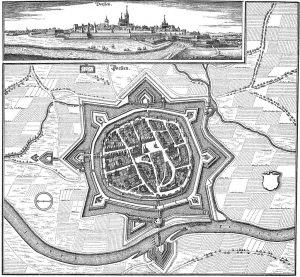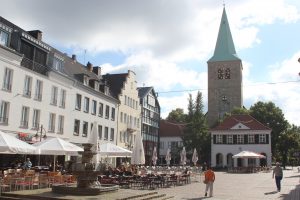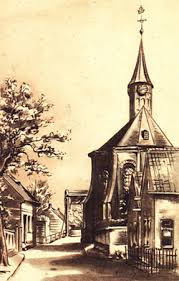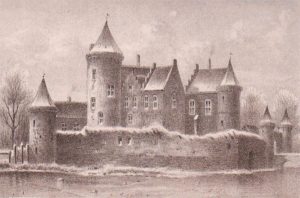Background – Origin Name
There are a number of possible origins for the name of Dorsten which are all explained below:
- The most important is the (at the time) important Hanseatic town of Dorsten at the river Lippe in Germany close to the Netherlands.
- An alternative is the small but old village Dorst between Breda, Oosterhout and Tilburg.
- In the 13th century, there was a court Dorsteen at Wismar in Northern Germany where the origin later bastardized to Dorsten.
- For the Jutphaas family tree, there is the theory that the name originates from the place Dorssen that there would have be (early 9th century).
- There are still a few alternatives, but those are very unlikely as origin. For example, there is the village of Dorste at Göttingen, one more village of Dorst further away in Germany and Dorssen (or Dorschen) in Poland (at that time, Germany). These are not further explained.
Dorsten (Hanseatic town)
The main origin of the name of Dorsten is the place Dorsten (comprehensive German-language description on Wikipedia) at the bottom of the German land of Lower Saxony (right above the Ruhr area and the State of North Rhine Westphalia and not far from the Dutch border at Gelderland). It got already city rights in 1251 and belonged to the important Hanseatic cities. At the time, the place Dorsten was mainly focused on the current Netherlands (given the trade) and other Hanseatic towns in Northern Germany and around the Baltic Sea. At that time, citizens of this origin registered in many Dutch cities. And the clergy was focused on the diocese of Cologne (and the diocese of Utrecht was also part of it at that time).In the Westphalian it is Dössen, the German name is Dorsten.
 The region near the town of Dorsten was already early inhabited and the Romans had here around the beginning of our era been a fortress, built a bridge over the Lippe and a castle. In late Antiquity until the end of the 5th century a village (upper) was built carrying the name “Durstina” and that lay North of the Lippe. At the same time was also a farm with vineyard on the South side built with the name “Durstinon”. This was at a shallow Ford in the river. In the two hundred years after, the area to the South of these Christianized and came to belong to the Archbishop of Cologne. Later, the area north of the Lippe Christianized from the Archbishop of Utrecht. The town of Dursten, probably in the Carolingian family Maiores Domus, was in a donation of Plectrude (+ 725).
The region near the town of Dorsten was already early inhabited and the Romans had here around the beginning of our era been a fortress, built a bridge over the Lippe and a castle. In late Antiquity until the end of the 5th century a village (upper) was built carrying the name “Durstina” and that lay North of the Lippe. At the same time was also a farm with vineyard on the South side built with the name “Durstinon”. This was at a shallow Ford in the river. In the two hundred years after, the area to the South of these Christianized and came to belong to the Archbishop of Cologne. Later, the area north of the Lippe Christianized from the Archbishop of Utrecht. The town of Dursten, probably in the Carolingian family Maiores Domus, was in a donation of Plectrude (+ 725).
In the beginning of the 10th century (around 900-910) Athalgard donates in memory of her dead husband Abbo the Abbey Werden in Dorsten a court, which later was called Leemwysche, and courts in Galen (Dorsten-Hardt and Ostrich). The Court in Dorstinon had to sell and organize hostels nature and belonged to the Court Heldringhausen in Recklinghausen. Abbo and his widow Athalgard are the first aristocrats of a noble family in Dorsten, belonging to the glory in and around Dorsten. This Dominion of nobles of Dorsten persists until the 11th century when the family becomes extinct. The monastery in Xanten draws here a parsonage and extends the belongings from and by the end of the 12th century a church village with the name Dorsten (on the site of Durstina). In 1176 the first church was built.
The fledgling settlement grew particularly due to its strategic location at the Lippe (long time here was the only bridge over the Lippe between Wesel and Haltern) and its location on major trade routes to Cologne about Bottrop, Essen, Münster and the way to Recklinghausen. In 1251 the Bishop of Cologne in consultation with the graves of Kleve granted city rights to Dorsten. In 1334 the first city wall was built; the city by the location on the Lippe was a member of Hanseatic League in the 14th century. Dorsten has gained great wealth through trade and shipbuilding and became the richest city of the fortress Recklinghausen. In the heyday of the 15th century, Dorsten exists of about 300 houses. In 1459 the plague prevailed in Dorsten.
In 1567 the city weighhouse to the market was built, which later also served as town hall. By the faith wars at the end of the 16th century and, above all, by the thirty years war at the beginning of the 17th century, trade and traffic came to a halt and attacked the Hansa apart. In 1641, there was the siege of Dorsten and up to the 18th century, the place regularly was besieged by armies of foreign powers.
 Dorst (at Breda)
Dorst (at Breda)
Although the name is Dorst and most people coming from here in the 16th century called themselves Van Dorst, is in any case of the Dordrecht tribe demonstrated that these came from Dorst and there was another strain of Van Dorsten in Breda too, which probably came from here. Exactly known is the origin of the name “Dorst” not (C.J. Walker). It is very likely that the name originated from “the horst”, an elevated strip of land, which in many cases, settlements were founded. One wrote the names on as one she uttered: “de Horsten” was, quickly pronounced, “Dorsten”. Much later, the name “Dorsten” changed to “Dorst”.
Dorst was first mentioned in 1290, then in 1323 and then regularly. Willem van Duivenvoorde in 1325 was lord of Oosterhout and, therefore, also from Dorst. In 1511 was the first mention of a chapel. The village was poor: North lay a skimpy heathland area and in the South it was found a marshy area, the Goor called. To put in the living one in the goat breeding. Goats milk, which also supplied to the health of farmers and their children was of great importance. From the end of the 15th century, in the area (Breda, Oosterhout) there are many reports in the archives of people coming ‘van Dorst’.
Dorssen (at Vreeland)
 According to the family tree of Jutphaas (see analysis there) it is originated from this place. This is based on a theory that the family originated from the well-known old Utrecht family Van Dorssen with a family tree in Vreeland.Below is a brief overview of the history of Dorssen and the doubts that you can place in this.
According to the family tree of Jutphaas (see analysis there) it is originated from this place. This is based on a theory that the family originated from the well-known old Utrecht family Van Dorssen with a family tree in Vreeland.Below is a brief overview of the history of Dorssen and the doubts that you can place in this.
The (still existing) name Dorssewaard is according to theory named after the settlement Dorssen (Dorsken, Dursken) who have been here in the seventh or eighth century would have been present. Some have described the settlement on the site of the current Vreeland, others think rather just across the old Vecht. At the archaeological research in this area are, however, no vegetation horizons, archaeological indicators or other indications for habitation remains found. At the onset of Vreeland (see below), however, it no longer existed.
To defend the border of its area and to prevent anyone else from toll would impose on the Vecht, the Bishop of Utrecht from 1252 onwards built the castle “Vredeland” on a higher place in the bend of the river Vecht. This River was an important trade route from Utrecht to the Zuiderzee (and on to the Baltic Sea). The building of the castle gave the boost up to the growth of Vreeland that got town rights in 1265. The city Vreeland has never become a full fledged city, partly because many craftsmen were transferred around 1275 to the emerging Amsterdam.
Comments on Dorssen as origin:
- The place Dorssen (Vreeland) is never shown, and would otherwise be a poor area and hundreds of years before the emergence of Vreeland have been a settlement. Then it is strange that people had this last name in that time, a distinguished family, but not of nobility, and would live there (in that case you won’t take that name).
- The area was governed by the Bishop of Utrecht (and this fell until 1559 under the Archbishop of Cologne). The Hanseatic City of Dorsten was already an important place and there were already several clerics, merchants, and others known (with this name) in both dioceses between 1200 and 1500.
- Nicolaes and Hugo van Dorssen were already mentioned in 1285 by the deposit of Amstel in Nigtevegt, Loosdrecht and Vreeland. The (known) family Van Dorssen fell within the circle of the Archbishop of Utrecht, in the Registrum Guidonis of the Bishop of Utrecht was referred to various members of this family between 1301 and 1317 (same Hugo, but also Vrederic and Henric). It therefore seems that they bought the ground at Nigtevegt from the Bishop.
- Dorsten became in the province of Utrecht more often written as Dorssen (and vice versa) and apparently pronounced.
- The ancestor of Van Dorssen in Amersfoort is a Van Dorsten from Doesburg and keeps the name until the early 18th century. Also in Utrecht the name splits in two branches with Van Dorssen and Van Dorsten.
Dorsteen (at Wismar)
The Court Dorsteen is sold in 1277 by Duchess Anastasia of Mecklenburg to the city Wismar and also earlier that century already mentioned and in the centuries after. It was owned by two Knights of Threshing Lewetzow and was first called Dorsteen and only then Dorsten. In the period 1359-1390 a variety Van Dorstens were reported in the nearby Hanseatic City Rostock. These could be from the Court, but also from the (other) Hanseatic City of Dorsten.